Surface designers can leverage their art in a number of different ways to earn an income, as seen in our 2023 Surface Design Industry Survey results.
For example, you could:
- Upload your art to a print on demand (POD) site.
- Create your own products and sell them directly to customers.
- Design custom artwork for companies as a freelancer.
All those income streams are beneficial, but there’s one option that I feel is THE best for surface pattern designers: art licensing. Art licensing is especially useful because you leverage art you already have.
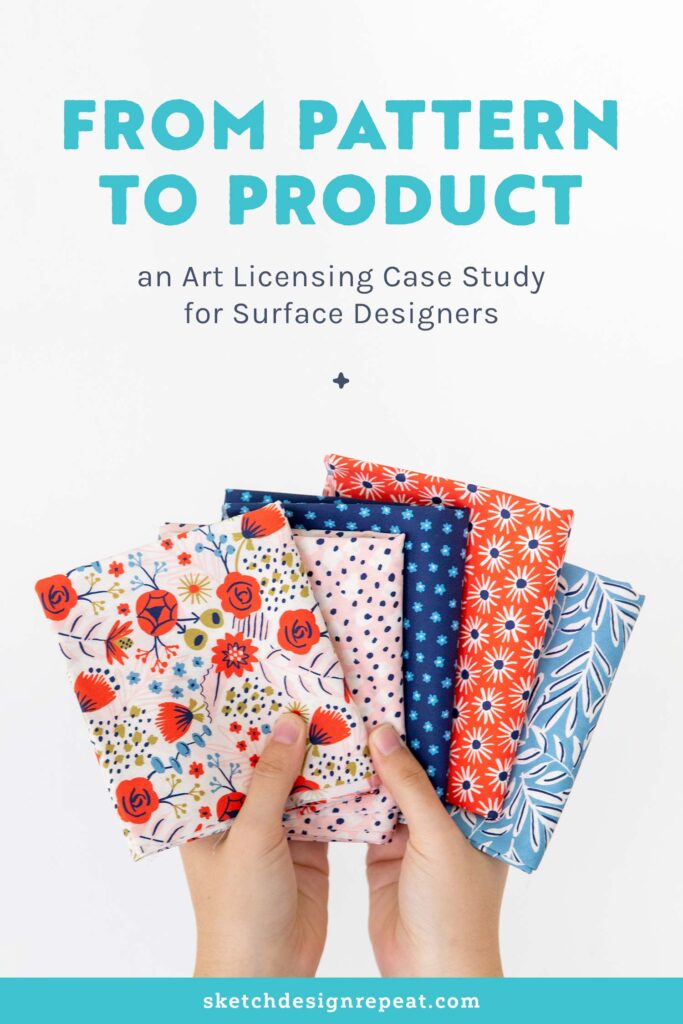
But if you’re unfamiliar with art licensing, it can be a fairly intimidating endeavor. So I’d like to share the journey of one of my favorite designs from my own surface design portfolio, from initial concept all the way to final product, to remove some of the mystery about the entire process.
My hope is that it’ll give you a better understanding of your own portfolio’s potential and the steps that are needed to get your art licensed.
First, what IS art licensing?
Art licensing is when you give a company permission to temporarily use your artwork on their products that they manufacture and sell, but you always keep ownership of the original artwork.
Think of it like you’re renting out your art for a few years.
The benefit is you can license the same piece of art to several companies at the same time (provided there’s no conflicting details in the contract) while still keeping the copyright of your work. And THAT means there’s no ceiling to the income potential of your designs!
Ok, now let’s see how that actually works in practice…
Step 1: Design
The design I’m highlighting in today’s case study was created in the fall of 2018. My main inspirational starting point for it was Marimekko style-florals, but with a more imperfect, gestural feel.
I purposefully used rough brushes in Procreate to give me the texture I was aiming for and in less than an hour, I’d drawn enough motifs for my hero pattern. Rarely does an idea in my head translate exactly as I see it in my sketchbook or iPad; this is one of those rare times it did!
However, designing the motifs was only the first step. I still had to get them into a full repeat and for me, that meant using Adobe Illustrator (my favorite program for patterns). For the record, you don’t have to use Illustrator to create patterns or find success in art licensing, so feel free to use whatever program you’re most comfortable with.
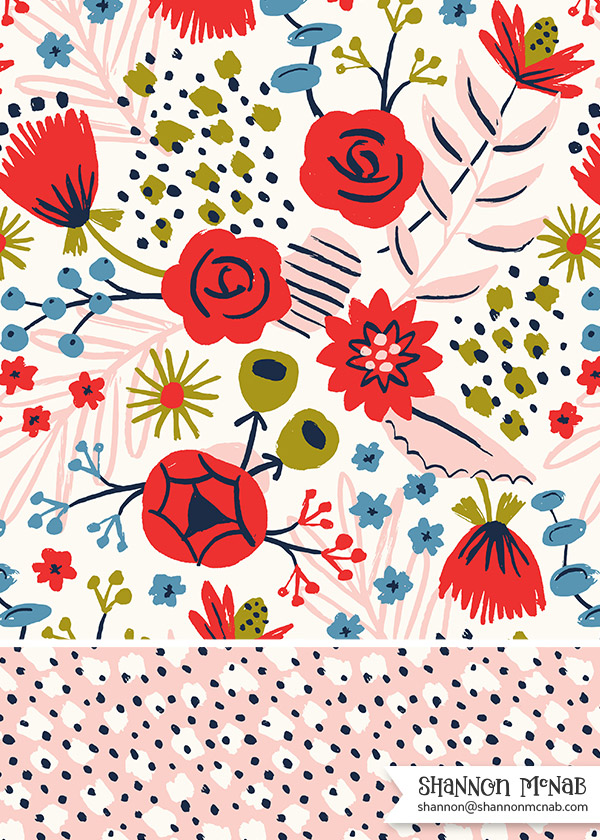
I imported my design from Procreate as flat JPGs, live traced each layer, built the repeat, and adjusted the color. However, once I completed it, I felt like it needed another pattern to complement it. So I extracted my second favorite part of the hero pattern — the smudgy polka dots — and created a simple coordinate from it.
But I still wasn’t quite done with the creation stage. Before I moved on to the next step, I saved my pattern duo as an individual portfolio sheet so I could more easily share it with companies I approached.
Unsure how to build your own portfolio sheets?
I’ve created a suite of portfolio templates based on my own portfolio you can use.
Step 2: Pitch
As a surface designer, your artwork doesn’t do any good if it just sits idle in your portfolio, so let’s fast forward a few months after I finished my design to January 2019. I was about 5 weeks away from exhibiting at Surtex for the 3rd time and was actively pitching my art to several companies I wanted to work with.
One of those companies was Hawthorne Supply Co as I was looking to break into the US fabric market. So I emailed the owner, shared a few pieces of my art with her (including my Bold Botanical design), and invited her to visit my booth. Since they operate out of NJ, I figured she’d be close enough to attend the show easily.
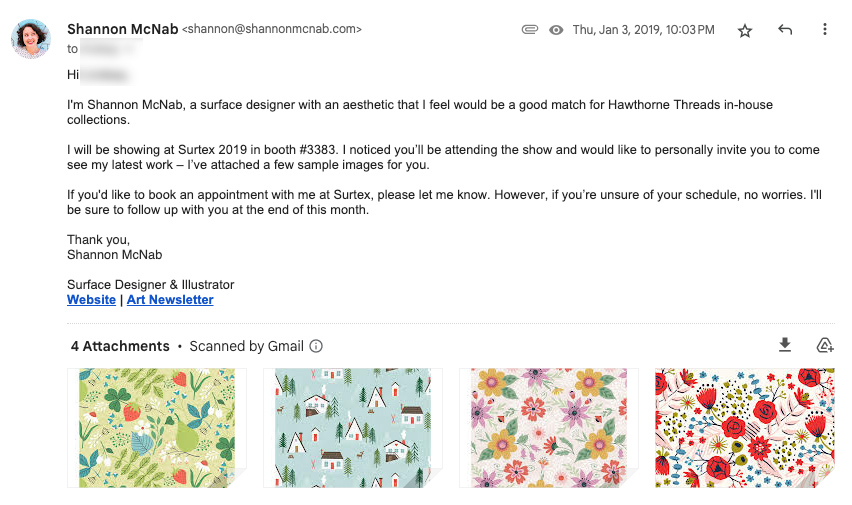
And as often happens when sending out a cold-pitch email… I never received a reply.
But guess what?!?
Not only did the owner show up at my booth on the very first day of Surtex, she revealed during our conversation that it was my Bold Botanical design from my email that caught her eye!! And that’s why contacting companies directly is so powerful.
Because if I’d never sent my pitch email to her, there’s no guarantee she would have seen me at Surtex that year.
By the way, I feel it’s important to mention this to normalize the fact that not receiving replies from pitch emails is very common. And yes, it sucks when it happens and your feelings of disappointment and frustration are valid. But don’t let it stop you from pitching your art!
Step 3: Follow Up
The most crucial part of the licensing process is the follow up and sadly, that’s where many artists drop the ball. In fact, when I polled artists on Instagram and asked how often artists contact companies, 41% said they only submit their art once.
But only pitching your art once isn’t enough.
Without emailing them again (and again and again) to share new art and stay near the top of their inbox, your entire licensing strategy can be summed up in one word: HOPE.
But hope isn’t likely to land you licensing deals. Instead, you should take an active approach and remind companies you exist, have great art to offer, and are eager to work with them.
That’s exactly what I did the week after I came home from Surtex in February 2019. I sent a follow-up email to the 45 great leads I generated from the show, including Hawthorne Supply Co.
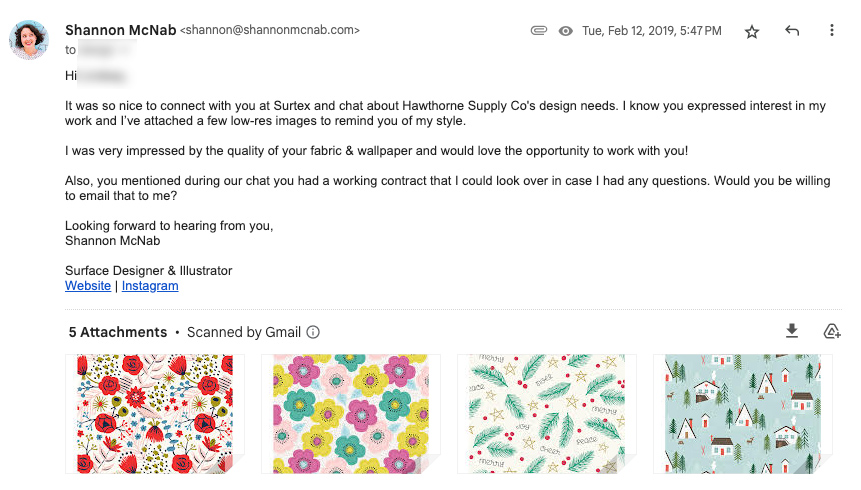
This time instead of radio silence, I received an immediate email reply where they asked me to create a full collection from my Bold Botanical design.
However, I want to reiterate that even after following up once, twice, even 10 times, your emails to art directors won’t always receive a response or end in a licensing contract. Again, this is absolutely normal!
In some cases, it’s taken 1–2 years of regularly emailing a company before I was able to finalize a licensing agreement with them. That’s why developing thick skin and staying persistent are the BEST things you can work on to keep from becoming demotivated.
Step 4: Negotiate
Even once a company has agreed via email to license one or more of your designs, there’s still work to do: negotiating the price and signing the contract.
You should always be well compensated AND without a mutually beneficial contract, you could end up giving away more rights than you need to — which means this part of the process can often take weeks or months.
Never be afraid to ask questions and negotiate for what you want.
Nearly everything in a contract is negotiable and you should only sign a contract when you have all the necessary information and are comfortable with the terms.
In my case, Hawthorne offered a very fair royalty rate, but there were several changes I requested for the contract. In the end, it took 6 rounds of negotiation over the course of 3 months before every detail was resolved, but the good news was they were very open to making changes (always a good sign when negotiating).
Speaking of negotiating, if you’re not even sure where to begin when it comes what pricing details you need in a licensing contract, I have an article that explains the three most important terms. Or if you want to learn absolutely everything about pricing and contracts, my Artful Pricing & Negotiation course is always here to help.
Step 5: Finalize & Send Art
Depending on what products your artwork will be on, you may have to make adjustments to your design before handing the final files over to a company’s art team.
It could be small things like a color change or changing the dimensions of an illustration OR they could ask for major changes/additions. If it’s the latter and you:
- Feel the changes you’re being asked to make will take a lot of time to complete
- OR think you won’t be able to leverage the additions they’ve asked for in other licensing opportunities
Then you should ask for additional compensation for the time you put in making the adjustments they’ve asked for. This’ll be easiest to ask for during the negotiation phase — just another reminder to make sure you have ALL the details before moving forward.
The majority of the time, I send art to companies as-is. However, Hawthorne Supply Co is a fabric company that prefers collections with a minimum of 5 patterns, so I knew I’d have to expand on my Bold Botanical duo.
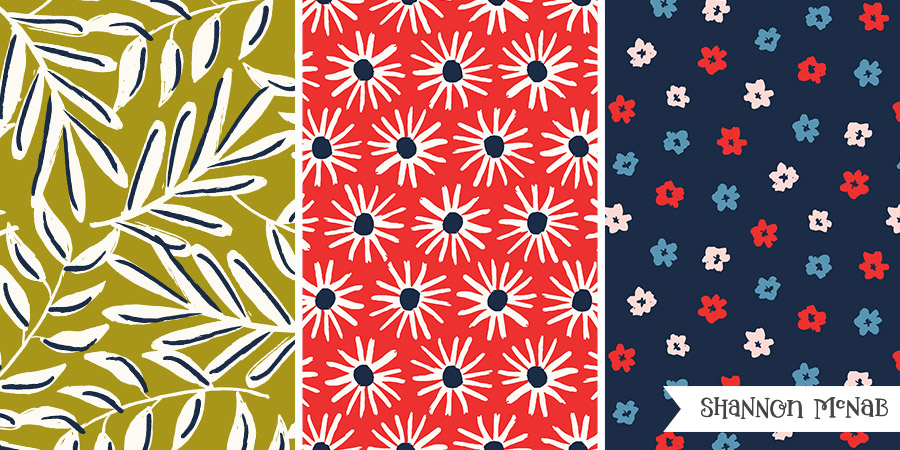
To keep things simple and cohesive, I pulled different elements out of the hero pattern (like I did for the polka dot print) and created three new coordinates which turned my Bold Botanical design into a 5-pattern collection.
Because I knew rounding out this collection would benefit its licensing potential, I didn’t ask for additional compensation. I also spent less than 2 hours of design time on it so I wasn’t doing a ton of work without getting paid for my time.
Related Article: 5 Tips for Preparing Your Art Files for Clients
Step 6: Wait (sometimes a long time)
Our part in the process as surface designers is mostly complete by this point, but once you’ve turned over the final artwork, there are several steps the company has to complete before the product is available for sale.
If you’re lucky, you might only wait a few months, but for companies that have a long development and manufacturing process, it could take up to 2 years before a product hits store shelves. And if you signed a royalty licensing agreement, you could wait an additional 1–6 months after a product is being sold to customers before you start getting paid.
With my Bold Botanical collection, I was really lucky because my fabric line debuted on Hawthorne Supply Co’s site just 2.5 months after we finalized the contract.
Step 7: Celebrate
There’s nothing quite like seeing your surface design artwork on a product out in the world. So when that moment finally arrives, don’t be shy about it. It’s your moment to shine and you should celebrate the heck out of it!
Of course you can do that privately with your family and fellow artist friends, but why not publicly share the news too! And if you’re receiving royalties on the products, this step is crucial because people who follow you could buy the product, which in turn means you’ll receive more money in your royalty checks.
So feel free to talk about it on Instagram, Facebook, LinkedIn, or wherever else you like to show up online.
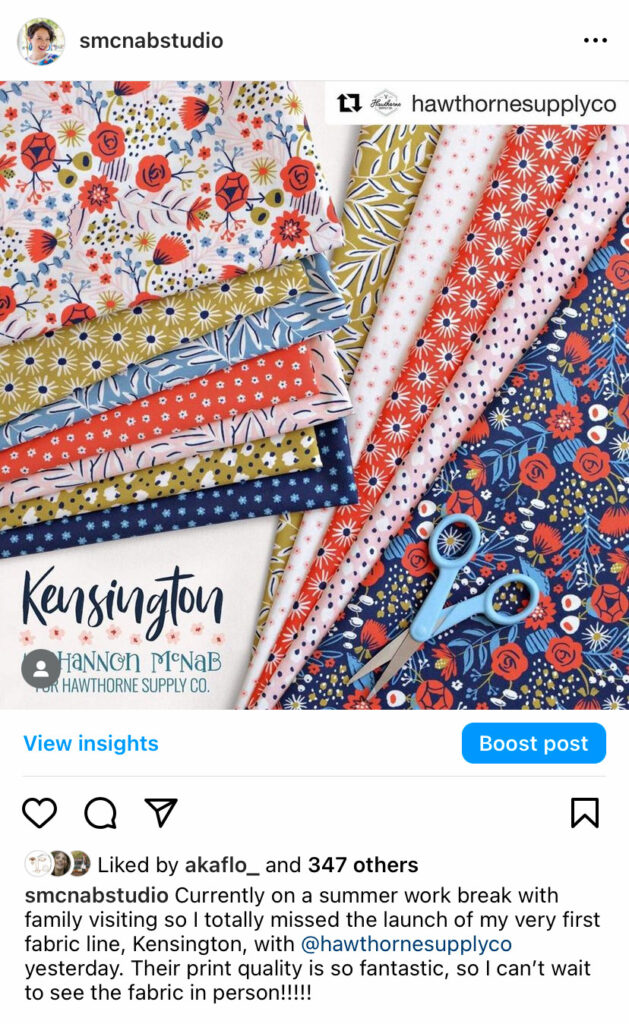
Step 8: Repeat
Now the entire process starts all over again with you creating new artwork. However, it’s a little different because once you’ve successfully signed a licensing agreement with a company, they become a client — YAY! But it’s up to you to continue to nurture your relationship with them, sending them any relevant new art you make.
Because it’s far easier to sign new contracts with an existing client than it is to land a new client. So don’t drop the ball!
Keep emailing clients regularly with new artwork and hopefully, over time the number of contracts and income with them will grow. In fact, in the years since my first fabric collection debuted, I’ve launched 7 other collections at Hawthorne Supply Co.
Also, don’t forget that while you’re working with your existing clients, you can pitch the SAME art out to non-competing companies. Like I did with Bold Botanical — in February 2021, another one of my regular clients, Entryways, licensed it for outdoor decor for this beautiful doormat.
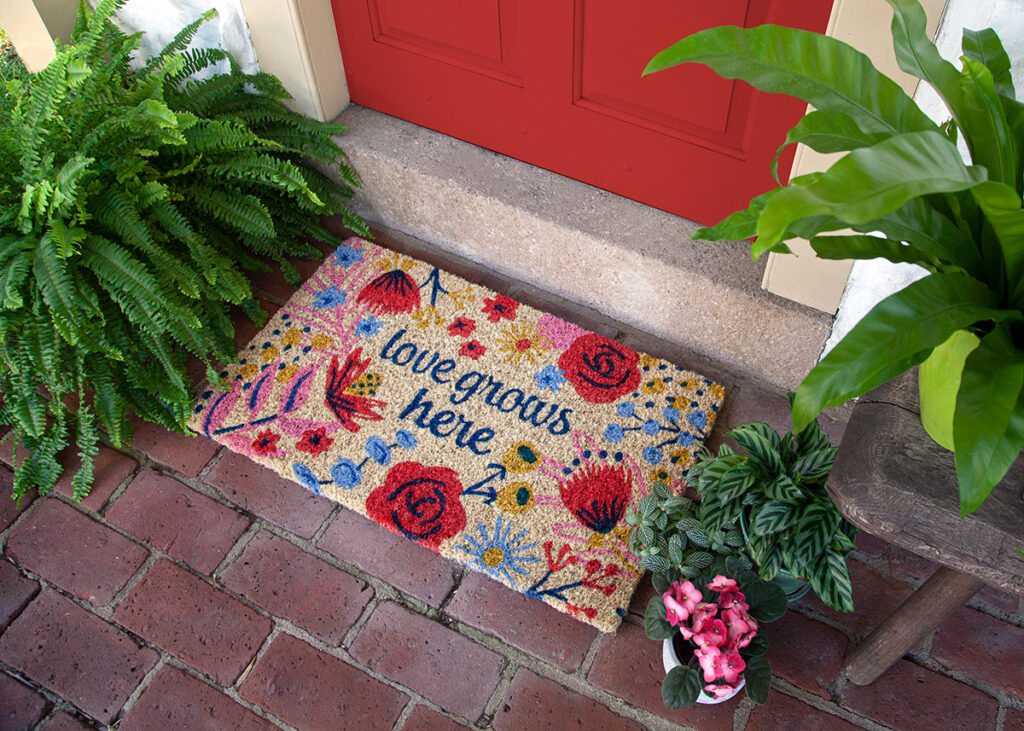
But there are many untapped markets where my Bold Botanical surface pattern design collection can STILL be licensed: stationery, bedding, gifts, women’s apparel, wrapping paper… the earning potential for this design is truly limitless!
That’s the MAGIC of art licensing: Leveraging your existing artwork multiple times throughout your career without tons of extra work.
And if you want to learn how to pitch your art and regularly follow up with companies, my art licensing course, Pitch Your Portfolio, can help. My sole focus in the course is to streamline this entire pitching process, helping you stay organized throughout – one of my superpowers 💪
Feel free to pin this handy chart below on Pinterest so you can reference it again later.
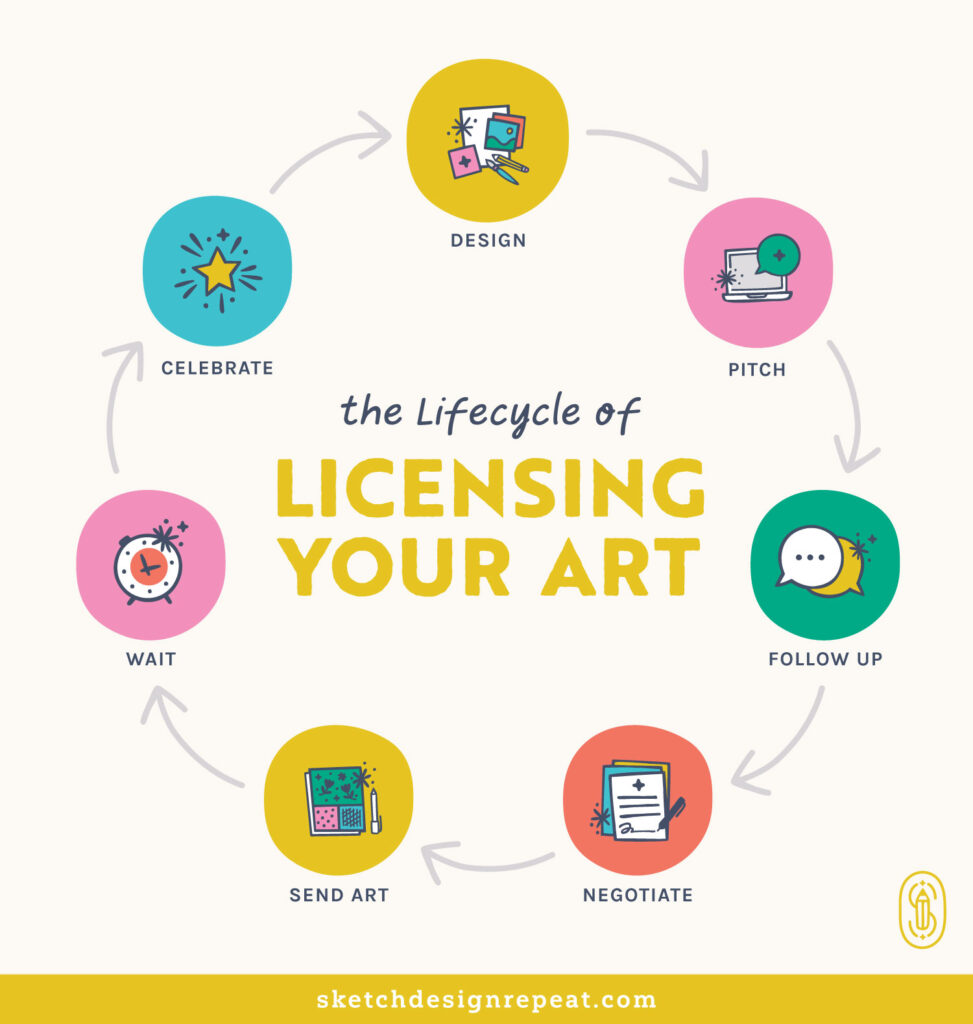
Great info, thanks for sharing, Shannon! Beautiful artwork 🙂
Hey Shannon,
Just wanted to say you do such a nice job giving useful info. I follow lots of people in the industry to see new tidbits:) And the way you inform people new to the industry is really, really awesome. Just wanted to send ya a note. You are clearly working really hard!
I love your posts, they’re always very motivational and packed with useful information!
This is so helpful, just feeling the process come to reality is so reassuring. Out of interest… When you add into your contract about the non-exclusive element of the use of designs… How do the clients feel if they know the design is likely to be placed on other products? How do you begin to negotitate if they want exclusive rights for say 3 years …?
Thank you for sharing your process it sounds very confident and knieing… Much appreciate this.
Best wishes,
Tracy
Tracy – Personally, I don’t offer fully non-exclusive options as most of my clients want exclusivity for their products/category. For art licensing, when a company licenses a design for let’s say stationery, they usually expect that the same design could appear on other products by other companies – it’s just how the system works. What’s important is to keep very good records for what rights have been given for each design so you don’t offer a design that isn’t actually available to a company.
And if you’re wanting some in-depth help on negotiating contract terms, my Artful Pricing & Negotiation course is always available: https://sketchdesignrepeat.com/artful-pricing-and-negotiation
Really inspiring story thanks Shannon.
@lucy6131
Bountiful Design
Thank you for this information, it is most helpful. I must admit to previously failing to follow up with companies but now I am much better at doing this and have a spreadsheet to help me keep track.
Hi Shannon, you make the process of pitching to companies sound so manageable. I’m a complete beginner and don’t have the skills as yet, but I would love to give surface design a try. Thank you for your newsletter and business insights. Greetings, Simone from Germany